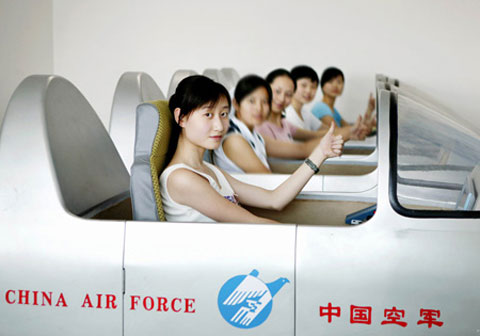China is about to bring the first pink ball to space
China may have the first female astronaut this year, after some women are put into training for manned connections in the universe.
Three astronauts will be present on the Shenzhou 9 ship between June and August of this year, to conduct the pairing with the Thien Cung-1 module flying in orbit of the earth, Xinhua quotes one. officials of China's manned space program.
A group of astronauts, including some women, are training for the above-mentioned connection task. The 3-person crew will be selected among them at the last minute, the official named Niu Hongguang said.

The girls have the opportunity to become the first female cosmonaut in China
choose from soldiers of this country's air force. (Artwork: Shanghaiist)
After the Shenzhou 9 ship and the Heavenly Palace 1-1 meet at a rendezvous in space, astronauts will temporarily move inside Thien Cung-1, where they will conduct scientific experiments. Thien Cung-1, China's first space station module, was launched into orbit in September 2011.
This connection mission is the latest development in the program aimed at helping China have a fixed space station in 2020. The unmanned Shenzhou 8 spacecraft returns to Earth in November 2011, after when completed twice with Thien Cung-1, in the first time China conducted unmanned pairing on the universe. This is a complicated job because the two spacecraft are moving at high speeds in orbit. Mastering the coupling technology on the universe is a simple task that Russia and the US have done in the 60s of the last century.
China considers the space program a symbol of its global stature, as well as its ability to develop technology. The program is aiming to set up China's space station, where a crew can exist independently for several months, like the Russian Mir station or the International Space Station (ISS). China first brought its citizens into space in 2004 and has since carried out a number of human-involvement tasks in space.
- China will conduct a space walk in 2007
- How to distinguish Vietnamese pink and standard Chinese pink without correction
- From the next 5-15 years, China will bring people into space
- Stunned with the impressive beauty of 'pink desert' in China
- Europe wants China to bring people to space
- Video: Astronaut kicks on ISS
- Discover the mysterious golden ball in the universe
- 2007: China put 3 people into space
- China intends to operate the new space station in 2022
- China will launch larger spacecraft
- China revealed its mission to secretly bring dogs to space
- Video: Unbelievably deformed golf ball
 Van Allen's belt and evidence that the Apollo 11 mission to the Moon was myth
Van Allen's belt and evidence that the Apollo 11 mission to the Moon was myth The levels of civilization in the universe (Kardashev scale)
The levels of civilization in the universe (Kardashev scale) Today Mars, the sun and the Earth are aligned
Today Mars, the sun and the Earth are aligned The Amazon owner announced a secret plan to build a space base for thousands of people
The Amazon owner announced a secret plan to build a space base for thousands of people